Introduction
The Colebrook-White equation is recommended for use by those unfamiliar with pipeline flow equations. It will produce the greatest consistency of accuracy over the widest possible range of variables. This equation is limited for use when the Reynolds number exceeds 4000.
The friction factor is solved using the Newton-Raphson method.
f=\frac{64}{Re};\,Laminar\,Flow: Re < 2000 \~\ \frac{1}{\sqrt{f}}=2\log_{10}(Re\sqrt{f})-0.8;\,Smooth\,Pipe:Re >4000\,and\,\frac{\varepsilon}{D}\rightarrow0\~\ \frac{1}{\sqrt{f}}=-2\log_{10}\biggr(\frac{\varepsilon}{3.7D}+\frac{2.51}{Re\sqrt{f}}\biggr);\,Transitional,\,Colebrook-White\,Eq,Re>4000\~\ \frac{1}{\sqrt{f}}=1.14-2\log_{10}\biggr(\frac{\varepsilon}{D}\biggr);\,Wholly \,Rough
f=\frac{64}{Re};\,Laminar\,Flow: Re < 2000 \\~\\ \frac{1}{\sqrt{f}}=2\log_{10}(Re\sqrt{f})-0.8;\,Smooth\,Pipe:Re >4000\,and\,\frac{\varepsilon}{D}\rightarrow0\\~\\ \frac{1}{\sqrt{f}}=-2\log_{10}\biggr(\frac{\varepsilon}{3.7D}+\frac{2.51}{Re\sqrt{f}}\biggr);\,Transitional,\,Colebrook-White\,Eq,Re>4000\\~\\ \frac{1}{\sqrt{f}}=1.14-2\log_{10}\biggr(\frac{\varepsilon}{D}\biggr);\,Wholly \,Rough𝑓 − Friction Factor
D – Inside Pipe Diameter[in]
𝜀 − Pipe Roughness[in]
H=f\bigg( \frac{L}{\frac{D}{12}} \bigg) \bigg( \frac{V_C^2}{2G} \bigg) \~\ V_C=\frac{Q}{A}=\frac{\frac{\frac{\pi D^2}{4}\sqrt{2GH}}{f(\frac{L}{D})}}{\frac{\pi D^2}{4}}
H=f\bigg( \frac{L}{\frac{D}{12}} \bigg) \bigg( \frac{V_C^2}{2G} \bigg) \\~\\ V_C=\frac{Q}{A}=\frac{\frac{\frac{\pi D^2}{4}\sqrt{2GH}}{f(\frac{L}{D})}}{\frac{\pi D^2}{4}}𝐻 − Head Loss[ft]
𝐿 − Pipe Length[mi]
𝑉𝐶 − Average Velocity[ft/sec]
𝑓 − Friction Factor
D – Inside Pipe Diameter[in]
𝐺 − Liquid Specific Gravity
𝐴 − Area[ft2]
𝑄 − Flow Rate[BPD]
HP_1=HP_2-H_1+H+H_2 \~\HP_2=\frac{P_2}{.433514SG} \~\ P_1=.433514(SG)(HP_1) \~\\triangle P=P_1-P_2
HP_1=HP_2-H_1+H+H_2 \\~\\HP_2=\frac{P_2}{.433514SG} \\~\\ P_1=.433514(SG)(HP_1) \\~\\\triangle P=P_1-P_2𝐻𝑃1 − Upstream Head Pressure[ft]
𝐻𝑃2 − Downstream Head Pressure[ft]
𝐻1 − Upstream Elevation[ft]
𝐻2 − Downstream Elevation[ft]
𝐻 − Head Loss[ft]
𝑆𝐺 − Specific Gravity
𝑃1 − Upstream Pressure[psig]
𝑃2−Downstream Pressure[psig]
Case Guide
Part 1: Create Case
- Select the Colebrook-White application in the Hydraulics module.
- To create a new case, click the “Add Case” button.
- Enter Case Name, Location, Date and any necessary notes.
- Fill out all required parameters.
- Make sure the values you are inputting are in the correct units.
- Click the CALCULATE button to overview results
Input Parameters
- Temperature base(°F)
- Pressure base(psia)
- Gas Flowing Temperature(°F)
- Liquid Specific Gravity
- Compressibility Factor
- Pipeline Efficiency Factor
- Downstream Pressure(psig)
- Upstream Pressure(psig)
- Absolute Pipe Roughness
- Flow Rate(Barrels per Day)
- Internal Pipe Diameter(in)
- Length of Pipeline(mi)
- Kinematic Viscosity
- Upstream Elevation(ft)
- Downstream Elevation(ft)
Downstream Pressure
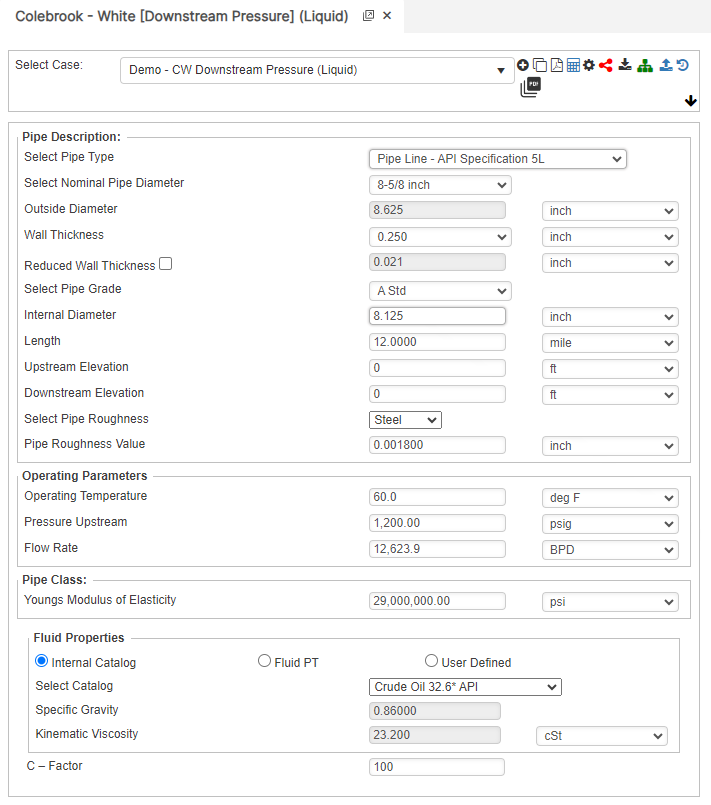
Flow Rate
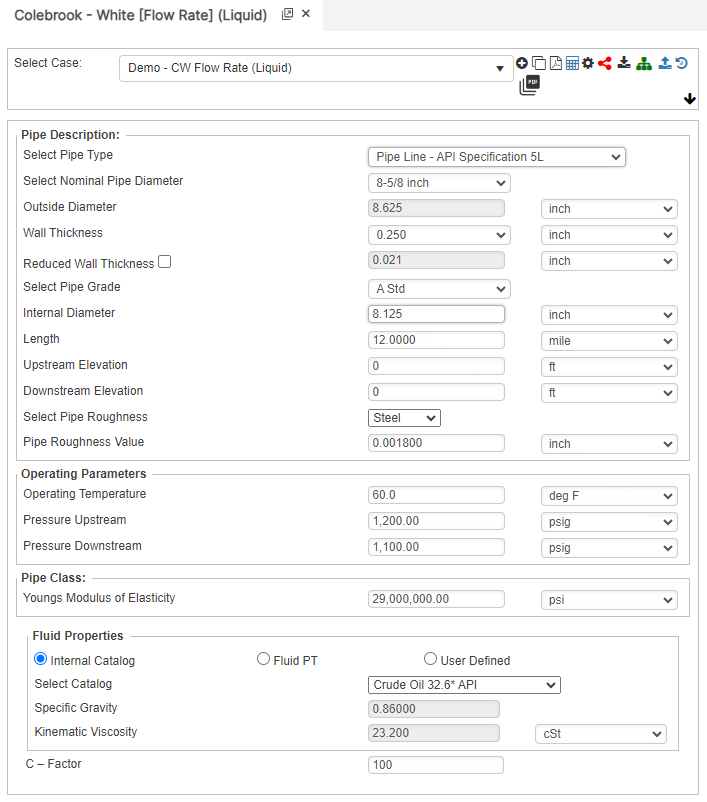
Internal Pipe Diameter
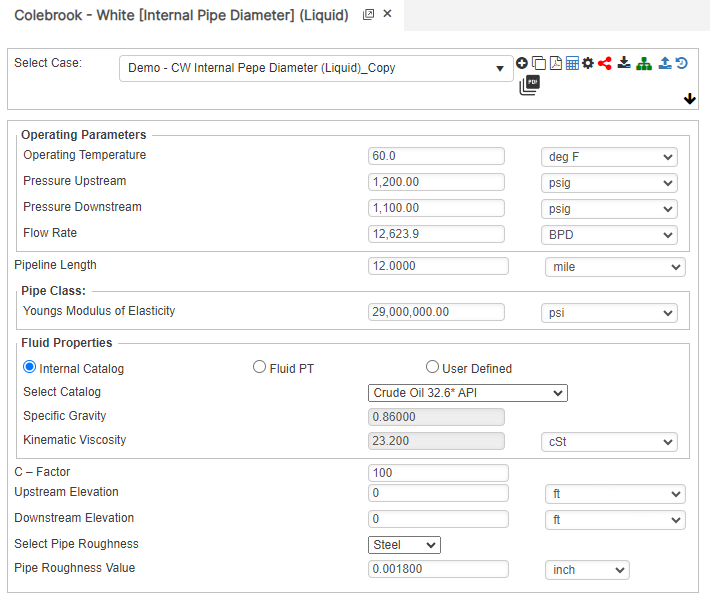
Upstream Pressure
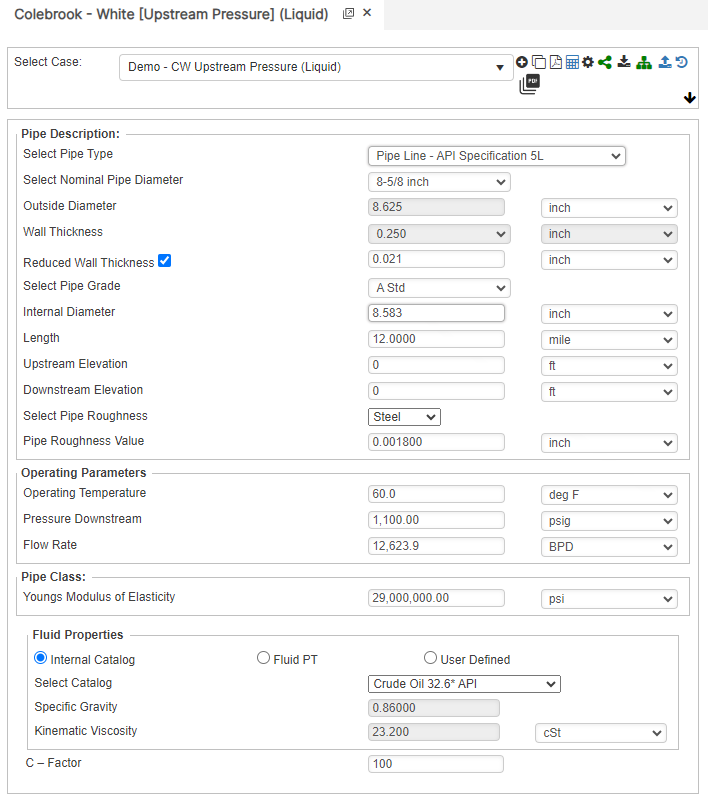
Part 2: Outputs/Reports
- If you need to modify an input parameter, click the CALCULATE button after the change.
- To SAVE, fill out all required case details then click the SAVE button.
- To rename an existing file, click the SAVE As button. Provide all case info then click SAVE.
- To generate a REPORT, click the REPORT button.
- The user may export the Case/Report by clicking the Export to Excel icon.
- To delete a case, click the DELETE icon near the top of the widget.
Results
- Friction Factor
- Head Loss [ft]
- Pressure Loss [psi/mi]
- Downstream Pressure(psig)
- Flow Rate(Barrels per Day)
- Internal Pipe Diameter(in)
- Upstream Pressure(psig)
- Average Velocity(ft/sec.)
- Erosional Velocity (ft/sec.)
- Sonic Velocity (ft/sec.)
Downstream Pressure

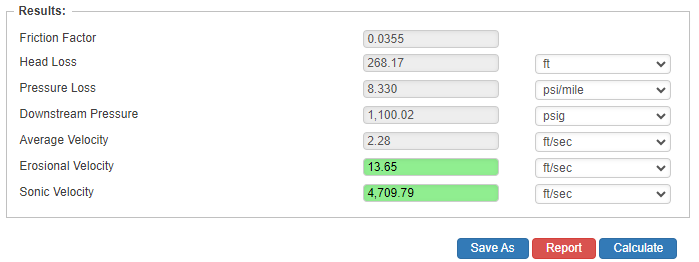
Flow Rate

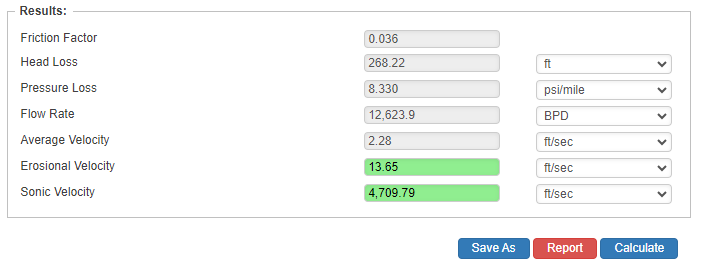
Internal Pipe Diameter

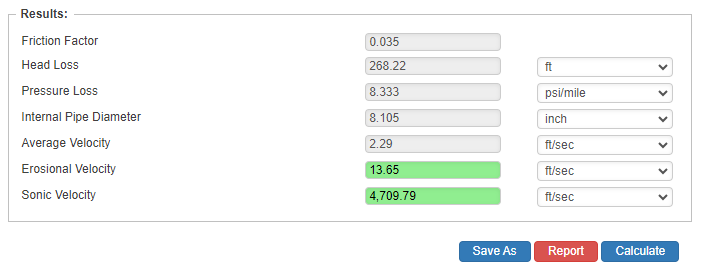
Upstream Pressure

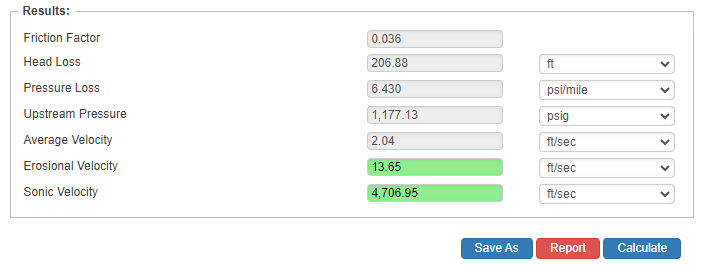
References
- McAllister, E. W., “Pipeline Rules of Thumb” Gulf Professional Publishing, Seventh Edition
- Menon, Shahi E., “Gas Pipeline Hydraulics”, Systek Technologies, Inc.
- Carroll, Landon and Hudkins, Weston R., “Advanced Pipeline Design”
- American Gas Association (AGA), “Reference: Eq-17-18, Section 17, GPSA”, Engineering Data Book, Eleventh Edition
FAQ
-
What is Erosional Velocity?
Pipe erosion begins when velocity exceeds the value of C/SQRT(ρ) in ft/s, where ρ = gas density (in lb./ft3) and C = empirical constant (in lb./s/ft2) (starting erosional velocity). We used C=100 as API RP 14E (1984). However, this value can be changed based on the internal conditions of the pipeline. Check Out
-
What is Sonic Velocity?
The maximum possible velocity of a compressible fluid in a pipe is called sonic velocity. Oilfield liquids are semi-compressible, due to dissolved gases. Check Out
